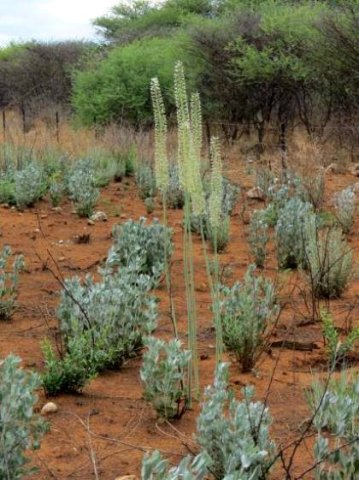Drimia altissima stems directly from the ground

Author: Ivan Lätti
Photographer: Piet Grobler
Flowering while leafless and the bulb totally underground! This is also Drimia altissima, a plant that may bear its scale-bearing bulb either half in sight or thus. At least some of the plants in this complex used to be called Urginea epigea but no more. Leaves grow next to the flower stem in an erect rosette, appearing later.
The inflorescence may be from 1,5 m to 2,5 m tall. The narrow cylinder formed by the small, white flowers with green tepal streaks has brought the plant the Afrikaans common name of maerman (lean man). More of its Afrikaans names like jeukbol (itch ball) and slangkop (snake head) are shared with other species in a cluster of plants with similarities. The open flower has its tepals reflexed, i.e. strongly curved back, closing again over the ovary as it withers.
There is a communal, rounded bract immediately below the lowest flower of the inflorescence, dropping early and already seems to have departed from the inflorescences in picture. In addition, each flower has its own small, spurred bract at the base of its pedicel. These bracts differentiate Drimia plants from Ornithogalum and Anthericum on which the bracts are not spurred.
The fruit capsule is distinctly three-chambered, the seeds glossy black, flattened and winged, adapted for wind dispersal.
The poisonous bulbs are widely used in traditional medicine, hopefully with sufficient care, while duiker and nyala browse the leaves with no known ill effects. The plant was used in the past for making soap (Pooley, 1998; Vahrmeijer, 1981; Van Wyk and Gericke, 2000; iNaturalist).

